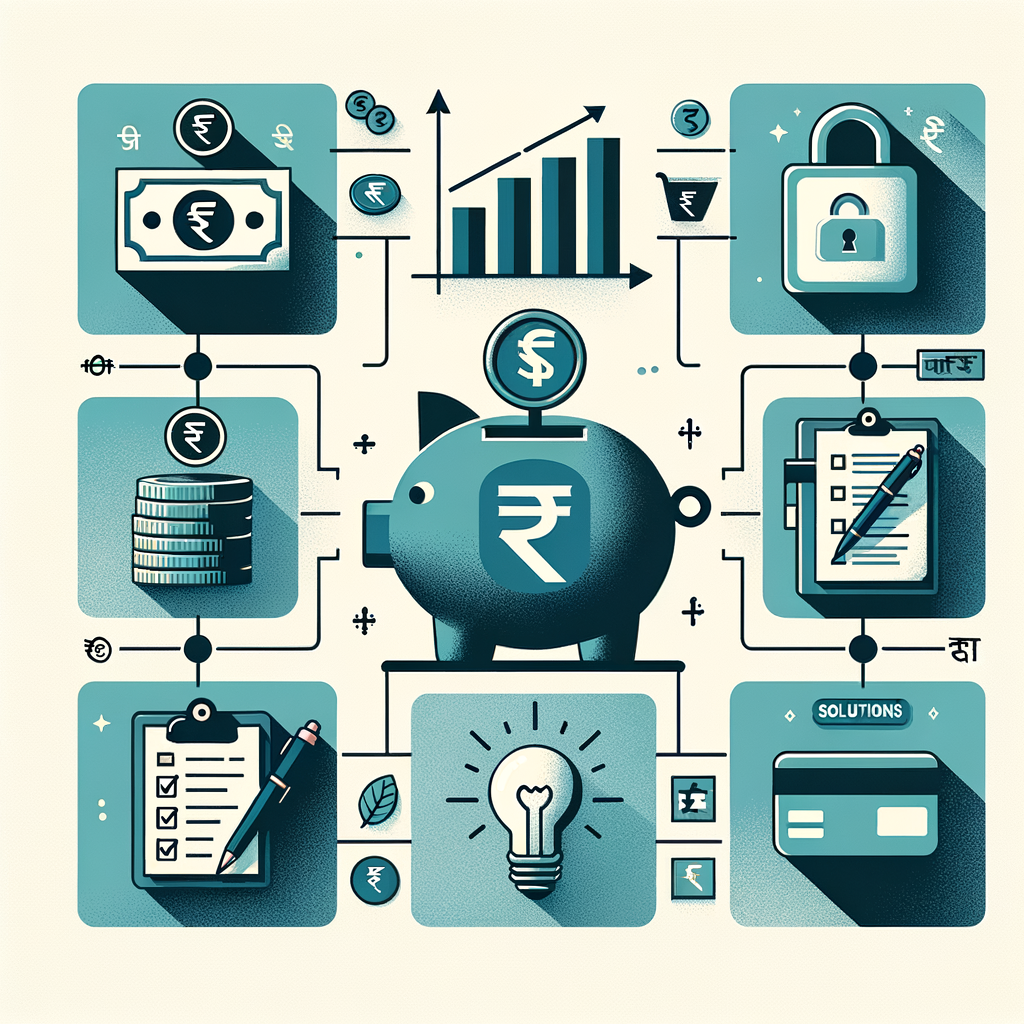Managing Unexpected Expenses: A Practical Guide for Indians to Avoid Credit Card Debt
Picture this: your refrigerator stops working in the middle of a hot May afternoon, your child needs an emergency dental procedure, or your car’s engine sputters to a halt on the way to a crucial meeting. The immediate stress is overwhelming, and the first instinct for many is to reach for a credit card. While convenient, this quick fix often leads to a dangerous debt trap. Relying on high-interest credit can quickly spiral out of control, especially in India’s dynamic economic climate. This guide is designed to change that reflex. We will provide actionable strategies for managing unexpected expenses proactively, offering practical personal finance tips India that empower both salaried professionals and small business owners to build true financial resilience without a credit card.
The Foundation: Building a Robust Emergency Fund in India
The single most powerful tool for managing unexpected expenses is not a credit card, but a well-funded emergency fund. This isn’t just a savings account; it’s your financial self-defence mechanism. Think of it as the foundation upon which all other sound budget strategies for unexpected expenses are built. Without it, any financial plan is vulnerable to collapsing under the pressure of a single unforeseen event. Creating and maintaining this fund is the first and most critical step towards financial independence and peace of mind.
What is an Emergency Fund?
An emergency fund is a dedicated pool of money saved exclusively for genuine, unforeseen financial crises. It’s the money you use when your AC breaks down, you face a sudden medical bill, or you experience a temporary loss of income. It is crucial to understand what this fund is not for. It is not a piggy bank for planned purchases like a new smartphone, a family vacation, a down payment on a car, or festival shopping. The discipline to use these funds only for true emergencies is what gives them their power.
How Much to Save: A Guide for Salaried Individuals vs. Small Business Owners
The ideal size of your emergency fund depends on your financial stability and income source. A one-size-fits-all approach doesn’t work.
- For Salaried Individuals: With a relatively stable monthly income, the goal should be to save 3 to 6 months’ worth of essential living expenses. This includes non-negotiable costs like rent or home loan EMI, utility bills, groceries, transportation, and insurance premiums. This cushion is vital for robust financial management for salaried individuals India, providing enough time to navigate a job loss or a significant medical event without taking on debt.
- For Small Business Owners: Due to the inherent volatility of business income and additional responsibilities, the safety net needs to be stronger. We recommend saving 6 to 9 months’ worth of both personal living expenses and critical business overheads. This includes personal costs plus business essentials like office rent, employee salaries, software subscriptions, and essential supplier payments. This larger fund protects both your family and your business from fluctuating cash flow or a sudden downturn in the market.
| Category | Salaried Individual | Small Business Owner |
|---|---|---|
| Recommended Savings | 3-6 months of essential living expenses | 6-9 months of personal and business expenses |
| Expenses to Cover | Rent/EMI, Utilities, Groceries, Transport | Personal expenses + Business Rent, Salaries, Overheads |
| Reason for Difference | Stable income stream | Variable income and higher financial risk |
Where to Park Your Emergency Fund
The money in your emergency fund must meet three critical criteria: it must be safe, liquid (easily accessible), and not lose value. This isn’t the place for high-risk investments like stocks.
- High-Yield Savings Account: This is the simplest and safest option. It’s fully liquid, allowing you to withdraw money instantly via debit card or UPI. Look for a bank that offers a slightly higher interest rate than a standard savings account and is insured by the DICGC (Deposit Insurance and Credit Guarantee Corporation) up to ₹5 lakh.
- Liquid Mutual Funds: These funds invest in very short-term, high-quality debt instruments. They typically offer slightly higher returns than a savings account and are highly liquid, with redemption requests usually processed within one business day (T+1). However, they carry a very low level of market risk and are not insured.
- Short-term Fixed Deposits (FDs): You can keep a portion of your fund in FDs. They are safe and offer fixed returns. However, ensure you choose FDs with minimal or no penalty for premature withdrawal, or opt for a “sweep-in” facility linked to your savings account for the best of both worlds.
Proactive Financial Habits: How to Manage Expenses Without Credit
Building an emergency fund is a reactive safety net. The next step is to develop proactive financial habits that reduce the frequency and impact of financial shocks. This section focuses on building systems that help you master how to manage expenses without credit in India by planning ahead and controlling your cash flow meticulously. These habits turn financial management from a stressful chore into an empowering routine.
Implement the ‘Sinking Fund’ Strategy
A “sinking fund” is a brilliant strategy for predictable, but non-monthly, large expenses. Instead of letting them hit your budget as a surprise, you plan for them by saving a small, regular amount each month. This turns a potential emergency into a planned expense.
How it works:
- Identify your major annual or semi-annual expenses: health insurance premiums, car insurance, annual maintenance contracts (AMCs), festival spending, or children’s school fees.
- Divide the total cost by the number of months you have to save.
- Set up a recurring transfer to a separate savings account for this amount.
For example, if your annual health insurance premium is ₹24,000, you can create a sinking fund by automatically saving ₹2,000 every month. When the premium is due, the money is already there, causing zero stress to your monthly budget.
Master Your Cash Flow with Regular Budgeting
You cannot manage what you do not measure. Knowing exactly where your money goes is the cornerstone of effective cost management India. Regularly reviewing your budget helps you identify wasteful spending, find opportunities to save, and allocate funds towards your financial goals, including your emergency and sinking funds.
- Track Your Spending: Use a budgeting app (like Walnut or Money Manager), a simple spreadsheet, or even a traditional notebook to track every single expense for a month.
- Categorize and Analyze: Group your expenses into categories like housing, food, transport, entertainment, and miscellaneous. This will reveal your spending patterns.
- Create a Realistic Budget: Based on your analysis, create a zero-based budget where every rupee of your income is assigned a job—whether it’s for spending, saving, or investing. Review and adjust this budget every month.
Negotiate Bills and Reduce Subscriptions
Many of our monthly expenses are not as fixed as we think. A little effort can lead to significant savings over time.
- Conduct a Subscription Audit: Make a list of all your recurring subscriptions—OTT platforms (Netflix, Hotstar), music streaming, gym memberships, and app subscriptions. Be honest about what you actually use and cancel the rest.
- Negotiate with Service Providers: Don’t be afraid to call your mobile, internet, or DTH provider once a year. Ask if you are on the best possible plan or if they have any new offers. Often, a simple phone call can result in a lower monthly bill.
Crisis Mode: Steps to Take When an Unexpected Expense Hits
Despite the best planning, emergencies happen. When they do, having a clear, logical action plan prevents panic and poor financial decisions. This sequence of steps is designed to help you navigate a crisis while reinforcing the core principle of avoiding credit reliance for expenses India.
Step 1: Assess and Quantify the Expense
Before taking any action, take a deep breath and get a clear picture of the situation. How much money is actually needed? Get a firm quote or estimate for the repair or service. Is this a one-time payment, or will it become an ongoing expense? Understanding the full financial scope of the problem is the first step to solving it without panic.
Step 2: Deploy Your Emergency Fund
This is the moment you prepared for. Do not hesitate to use your emergency fund. Its entire purpose is to be used in situations like this. Transfer the required amount from your emergency savings account or redeem your liquid funds. This action should feel empowering, not defeating—you are using a tool you wisely built to protect yourself.
Step 3: Temporarily Reduce Discretionary Spending
Once you’ve used a portion of your emergency fund, your immediate priority is to replenish it. The fastest way to do this is by temporarily cutting back on all non-essential, or discretionary, spending. This includes:
- Dining out and ordering in
- Shopping for clothes, gadgets, or other non-essentials
- Entertainment expenses like movies or weekend trips
Redirect all the money you save from these cutbacks directly into rebuilding your emergency fund until it’s back to its target level.
Step 4: Explore Alternatives to High-Interest Credit (Last Resort)
If the unexpected expense is larger than your emergency fund, it is still crucial to avoid credit cards and high-interest personal loans if at all possible. Explore these lower-cost alternatives first:
- Loan against Gold: If you have gold jewellery, a loan against it often comes with a much lower interest rate and faster processing time than a personal loan.
- Partial EPF Withdrawal: The Employees’ Provident Fund (EPF) allows for partial, non-refundable withdrawals under specific conditions, such as medical emergencies, home renovation, or education. You can check your eligibility and conditions on the official EPFO portal.
- Loan against Securities (LAS): If you have investments in stocks, mutual funds, or life insurance policies, you can take a loan against them. The interest rates are generally lower than personal loans.
Special Tips for Managing Unexpected Costs in Your Indian Business
Entrepreneurs and small business owners face a unique set of challenges where personal and business finances are often intertwined. Here are some specific tips for managing unexpected costs in India tailored for your business.
Maintain a Separate Business Contingency Fund
Just as you have a personal emergency fund, your business needs its own contingency fund. Crucially, always maintain separate bank accounts for your personal and business finances. This business fund is designed to cover specific commercial emergencies like a major client delaying payment, critical equipment failure, unexpected legal costs, or supply chain disruptions. This separation is fundamental for clear accounting and protects your personal savings from business risks.
Review Your Business Insurance Policies
Insurance is a non-negotiable tool for managing large, catastrophic business risks. Don’t just buy a policy and forget about it. Regularly review your coverage to ensure it aligns with your current business size and risks. Key policies to consider include:
- General Liability Insurance: Protects against property damage or injury claims.
- Professional Indemnity Insurance: Essential for service-based businesses to cover claims of negligence.
- Asset Insurance: Covers physical assets like machinery, computers, and inventory against fire or theft.
Foster Strong Vendor and Client Relationships
Business is built on relationships. Good, long-term relationships with your suppliers and vendors can be an invaluable lifeline during a cash crunch. A vendor you have a history of timely payments with may be more willing to offer flexible payment terms or an extended credit period if you face a temporary financial difficulty. This can provide a crucial interest-free buffer to navigate a tough spot without resorting to expensive debt.
Conclusion
Financial stability isn’t about avoiding life’s curveballs; it’s about being prepared to handle them when they arrive. True financial empowerment comes from proactive preparation, not from easy access to credit. By building a robust emergency fund, adopting smart habits like sinking funds and regular budgeting, and having a clear action plan for crises, you can confidently navigate financial uncertainties. Effective managing unexpected expenses is a learnable skill that protects your financial well-being and allows you, as an individual or a business owner, to thrive. This discipline is the key to breaking the cycle of debt and building lasting wealth.
Building a strong financial foundation involves smart planning, from budgeting to tax optimization. If you need expert guidance on managing your business finances or personal tax planning, contact TaxRobo today for a consultation.
Frequently Asked Questions (FAQs)
1. Is it a bad idea to use my credit card for an emergency even if I can pay it off in a few months?
While paying off the credit card bill in full is far better than carrying long-term debt, it’s a risky habit that can backfire. An unexpected delay in your income or another emergency could prevent you from paying it off, leading to hefty interest charges of 30-45% annually. The primary goal should be avoiding credit reliance for expenses India altogether by prioritizing your emergency fund. Use a credit card only as your absolute last resort after exhausting all other options.
2. How is a liquid fund different from a savings account for my emergency fund?
A savings account offers guaranteed (but low) returns and is insured by the DICGC up to ₹5 lakh, making it the safest option. A liquid fund is a type of debt mutual fund investing in very short-term instruments. It can potentially offer slightly higher returns but carries a very low level of market risk and is not insured. For absolute safety and instant access, a savings account is best. For potentially better returns with high liquidity and minimal risk, a liquid fund is a good alternative for a portion of your fund.
3. As a small business owner, what is the single most important first step?
The absolute first and most critical step is to open a separate business current account and legally separate your personal and business finances. This simple action is the foundation for everything else. It makes accounting, tax filing (like GST returns), and effective cost management India significantly easier and more accurate. It is essential for building both your personal and business emergency funds and presents a more professional image to banks and clients.
4. Can I get a loan from the government to handle an unexpected business expense?
Generally, no. Government loan schemes like MUDRA or Stand-Up India are primarily designed for capital expenditure (buying machinery) or business expansion, not for covering emergency operational costs or a sudden revenue shortfall. Your best bet for such situations is a business contingency fund. Having well-maintained books of accounts and a clear financial history, which TaxRobo’s accounting services can help with, will make it easier to secure a traditional business line of credit from a bank if needed. For more information on government schemes for MSMEs, you can visit the official Udyam Registration Portal.




I like how you highlighted the danger of turning to credit cards as a quick fix—it’s so common, yet so risky with high-interest rates. One thing I’ve found helpful in addition to an emergency fund is setting up small recurring savings ‘buckets’ for things like medical, car, or home repairs. That way, when the unexpected happens, it doesn’t feel like such a shock to the budget.
This is an essential, practical guide for financial resilience! 💯 The core message is powerful: proactive preparation (Emergency Fund/Sinking Funds) is far more empowering than reactive reliance on high-interest credit.
The differentiation between salaried individuals and small business owners is crucial, as business volatility demands a larger safety net. Just as a strong financial foundation protects against sudden shocks, discretion, professionalism, and vetting in the service industry protect against unforeseen personal or professional risks. Both demand a commitment to prevention over cure.
Focusing on cash flow mastery and avoiding the debt trap are the true keys to financial freedom. Great post! 💰🔒
I do trust all of the concepts you have introduced to your post. They’re really convincing and will definitely work. Nonetheless, the posts are very short for starters. Could you please lengthen them a bit from next time? Thanks for the post.
Hmm it seems like your site ate my first comment (it was super long) so I guess I’ll just sum it up what I submitted and say, I’m thoroughly enjoying your blog. I too am an aspiring blog writer but I’m still new to the whole thing. Do you have any points for novice blog writers? I’d really appreciate it.
You really make it seem so easy with your presentation but I find this topic to be really something that I think I would never understand. It seems too complex and very broad for me. I’m looking forward for your next post, I will try to get the hang of it!
I do agree with all the ideas you’ve presented in your post. They’re really convincing and will definitely work. Still, the posts are too short for beginners. Could you please extend them a little from next time? Thanks for the post.
Do you mind if I quote a couple of your posts as long as I provide credit and sources back to your blog? My blog site is in the exact same niche as yours and my visitors would definitely benefit from some of the information you provide here. Please let me know if this alright with you. Many thanks!
My developer is trying to persuade me to move to .net from PHP. I have always disliked the idea because of the costs. But he’s tryiong none the less. I’ve been using WordPress on various websites for about a year and am worried about switching to another platform. I have heard excellent things about blogengine.net. Is there a way I can import all my wordpress posts into it? Any help would be greatly appreciated!